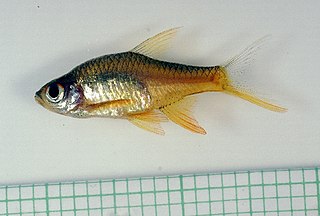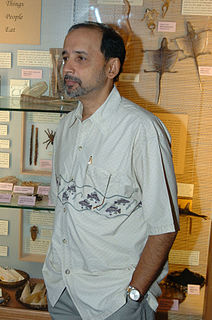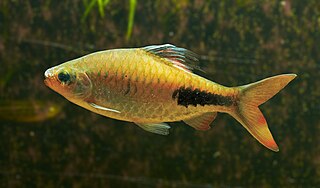
The black ruby barb or purplehead barb is a tropical cyprinid fish endemic to Sri Lanka, where it occurs in forested streams from the Kelani basin to the Nilwala basin. They are found in streams on hills around 1000 ft in elevation. The brightly colored population introduced to Mahaweli at Ginigathena, Sri Lanka, is said to have diminished in number due to the aquarium export trade.

The ticto barb or twospot barb is a species of subtropical freshwater fish belonging to the family Cyprinidae. It is a native of the upper Mekong, Salwen, Irrawaddy, Meklong and upper Charo Phraya basins in the countries of Nepal, India, Pakistan, Myanmar, Bangladesh, Thailand, and Sri Lanka. It has frequently been confused with the Odessa barb in the aquarium trade, but in that species the male is reddish-orange.

Rasbora is a genus of fish in the family Cyprinidae. They are native to freshwater habitats in South and Southeast Asia, as well as southeast China. A single species, R. gerlachi, is only known from an old specimen that reputedly originated from Africa (Cameroon), but this locality is considered doubtful. They are small, up to 17 cm (6.7 in) long, although most species do not surpass 10 cm (4 in) and many have a dark horizontal stripe.

The Arulius barb is a tropical cyprinid fish native to the Kaveri River basin of south east India. Other common names include Tamiraparani barb, Silas barb and longfin barb.

Garra is a genus of fish in the family Cyprinidae. These fish are one example of the "log suckers", sucker-mouthed barbs and other cyprinids commonly kept in aquaria to keep down algae. The doctor fish of Anatolia and the Middle East belongs in this genus. The majority of the more than 140 species of garras are native to Asia, but about one-fifth of the species are from Africa.
The bandula barb is a species of cyprinid endemic to Sri Lanka where it is only known from near Galapitamada in the Warakapola Divisional Secretariat. As this critically endangered species only was known from a single unprotected site where the population consists of an estimated 1,000 individuals, a second "insurance" population was established in 2014 by a team of IUCN scientists in cooperation with Sri Lanka's Forest Department, the Department of Wildlife Conservation and local communities.

Rasboroides vaterifloris, known as the pearly rasbora, vateria flower rasbora or fire rasbora, is a species of freshwater cyprinid fish endemic to Sri Lanka. It can be found in the shallow waters of shaded, slow-flowing clear streams with a silt substrate. It also prefers areas with plentiful leaf debris. Its diet consists of detritus and terrestrial insects. This species can reach a length of 4 centimetres (1.6 in) TL. It can also be found in the aquarium trade.
Pethia cumingii, known as the Cuming's barb or the two spot barb, is a species of cyprinid fish endemic to Sri Lanka.

Labeo dussumieri is fish in genus Labeo known to occur in west-flowing rivers of the Western Ghats. Earlier Sri Lankan population was considered as the same species as L. dussumieri, recent phylogenetic and physiological differences suggest that Sri Lankan population is a distinct species, Labeo heladiva..

Dawkinsia assimilis is a species of ray-finned fish in the genus Dawkinsia. It is endemic to the southern Western Ghats especially to the Southwest Indian states of Karnataka and Kerala. They are known as Mascara Barb. Filament barbs are a group of small freshwater fishes found in the rivers of peninsular India and Sri Lanka. There are nine species known under the genus Dawkinsia. These barbs are popular among aquarium hobbyists as an ornamental fish and are also collected from rivers and bred for trade.
Enteromius baudoni is a species of tropical cyprinid freshwater fish from Central and Western Africa. It is found in western Africa, in the river basins of the Chad Basin, the Volta basin, the Niger River basin, the Gambia River basin, the Senegal River basin, the Sassandra River basin, and the Bandama River basin. In central Africa, it is found in the Ubangui River ecosystem. It typically inhabits tropical freshwater ecosystems between 24 and 26 °C. It was originally described by Belgian-British zoologist George Albert Boulenger as Barbus baudoni in 1918, and the holotype, collected from Bangui, Central African Republic, is stored at the Muséum national d’Histoire naturelle in Paris. The species was originally classified in the Barbus genus, but was reclassified as belonging to the Enteromius genus in 2015 after examining extensive taxon, geographical, and genomic sampling of the species in the family Cyprinidae.

The horadandia, green carplet, or glowlight carplet, is a species of very small cyprinid fish that is found in slow-moving or still fresh and brackish water habitats in western Sri Lanka. Earlier thought to be a monotypic genus with the single species found in both Sri Lanka and India, an analysis published in 2013 showed that the Indian population should be recognized as a separate species, Horadandia brittani.

Rasboroides is a genus of small cyprinid fishes endemic to Sri Lanka. They are found in small, slow-flowing and shaded streams in the southwestern part of the island. They are essentially restricted to lowlands, although one introduced population occurs at an altitude of 980 m (3,220 ft). They are calm, social and attractively colored fish that sometimes are kept in aquariums.

Rohan David Pethiyagoda, is one of Sri Lanka's leading naturalists and a taxonomist on Freshwater fish of Sri Lanka.

Dawkinsia is a genus of cyprinid fishes from freshwater in South India and Sri Lanka. It was split off from genus Puntius in 2012.

Pethia is a genus of small freshwater fish in the family Cyprinidae native to South Asia, East Asia and Mainland Southeast Asia. Some species are commonly seen in the aquarium trade. The name Pethia is derived from the Sinhalese "pethia", a generic word used to describe any of several small species of cyprinid fishes. Most members of this genus were included in Puntius, until it was revised in 2012.

Rasboroides nigromarginatus is a species of freshwater cyprinid fish endemic to Sri Lanka where only known from small, shaded streams in the Atweltota region of the Kalu River basin. It can also be found in the aquarium trade.

Rasboroides pallidus is a species of freshwater cyprinid fish endemic to southwestern Sri Lanka. It is only known from shallow, slow-flowing streams in the basins of the Kalu River, Bentara River, Gin River, Polathu-Modera River and Nilwala River. It has been introduced to the Mahaweli and Walawe River basins, and is overall less threatened than the related R. vaterifloris.
The Sri Lanka tree crab,, is a species of freshwater crabs of the family Gecarcinucidae that is endemic to Sri Lanka. It is the only known tree climbing freshwater crab found in the country. The crab is discovered from 11 localities from Sri Lanka throughout Kalu River, Walawe River and Gin River basins. Adult are known to survive well in rainwater-filled tree hollows of trees such as Shorea sp., Artocarpus sp., Dillenia sp., Garcinia sp., Myristica sp., and Gyrinops walla. Females with youngs can be seen during February and March on the ground, never within tree hollows. The known predators are Greater coucal, White-throated kingfisher, Sri Lanka grey hornbill and Eurasian otter.
Horadandia brittani is a species of very small cyprinid fish that is endemic to coastal floodplains in South India. Originally described as a subspecies of H. atukorali, it was elevated to species level in 2013. It can grow to 2 cm (0.79 in) standard length.












